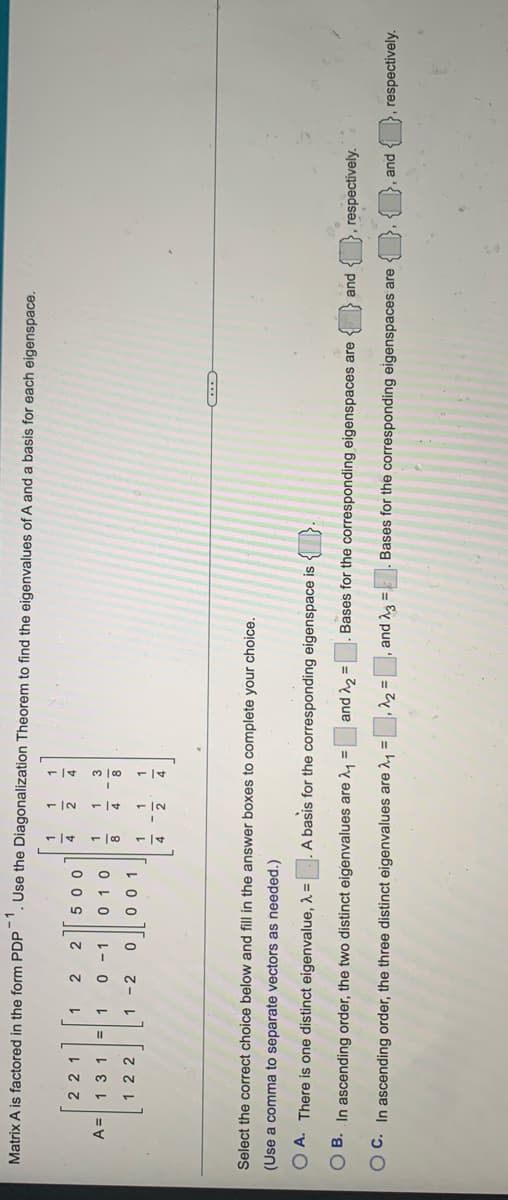-/4 1/4 1/2 ー|す - | 00 PDP'. Use the Diagonalization Theorem to find the eigenvalues of A and a basis for each eigenspace. 1. 2. 0 1 0 3. 8 - 1 L0 0 1 1. 4. 4. w and fill in the answer boxes to complete your choice. tors as needed.) genvalue, 1 = A basis for the corresponding eigenspace is Bases for the corresponding eigenspaces are = Zy pue ,?2=, and g = two distinct eigenvalues are = %3D pue three distinct eigenvalues are y = . Bases for the corresponding eigenspaces are
-/4 1/4 1/2 ー|す - | 00 PDP'. Use the Diagonalization Theorem to find the eigenvalues of A and a basis for each eigenspace. 1. 2. 0 1 0 3. 8 - 1 L0 0 1 1. 4. 4. w and fill in the answer boxes to complete your choice. tors as needed.) genvalue, 1 = A basis for the corresponding eigenspace is Bases for the corresponding eigenspaces are = Zy pue ,?2=, and g = two distinct eigenvalues are = %3D pue three distinct eigenvalues are y = . Bases for the corresponding eigenspaces are
Linear Algebra: A Modern Introduction
4th Edition
ISBN:9781285463247
Author:David Poole
Publisher:David Poole
Chapter4: Eigenvalues And Eigenvectors
Section4.5: Iterative Methods For Computing Eigenvalues
Problem 3EQ
Related questions
Question
2

Transcribed Image Text:Matrix A is factored in the form PDP
. Use the Diagonalization Theorem to find the eigenvalues of A and a basis for each eigenspace.
1.
221
2
4.
2.
0 0 9
131
L- 0
4.
22
1 -2
1
2
4.
Select the correct choice below and fill in the answer boxes to complete your choice.
(Use a comma to separate vectors as needed.)
O A. There is one distinct eigenvalue, 1 =
A basis for the corresponding eigenspace is
and ^2 =
Bases for the corresponding eigenspaces are
respectively.
O B. In ascending order, the two distinct eigenvalues are , =
pue
,^2 =, and 3 =
Bases for the corresponding eigenspaces are
respectively.
O C. In ascending order, the three distinct eigenvalues are 2, =
pue O
Expert Solution
This question has been solved!
Explore an expertly crafted, step-by-step solution for a thorough understanding of key concepts.
Step by step
Solved in 2 steps with 2 images

Recommended textbooks for you

Linear Algebra: A Modern Introduction
Algebra
ISBN:
9781285463247
Author:
David Poole
Publisher:
Cengage Learning

Elementary Linear Algebra (MindTap Course List)
Algebra
ISBN:
9781305658004
Author:
Ron Larson
Publisher:
Cengage Learning

Linear Algebra: A Modern Introduction
Algebra
ISBN:
9781285463247
Author:
David Poole
Publisher:
Cengage Learning

Elementary Linear Algebra (MindTap Course List)
Algebra
ISBN:
9781305658004
Author:
Ron Larson
Publisher:
Cengage Learning